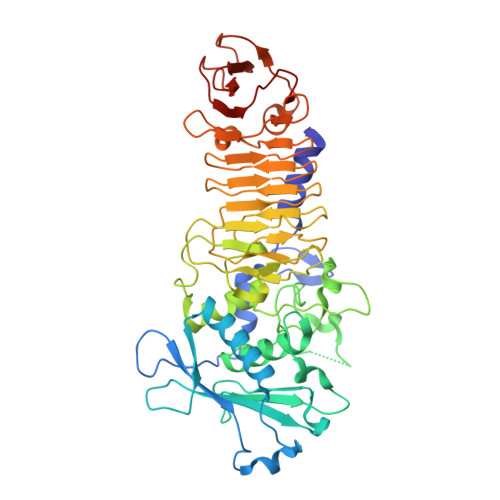Probing the role of divalent metal ions in a bacterial psychrophilic metalloprotease: binding studies of an enzyme in the crystalline state by x-ray crystallography.
Ravaud, S., Gouet, P., Haser, R., Aghajari, N.(2003) J Bacteriol 185: 4195-4203
- PubMed: 12837794
- DOI: https://doi.org/10.1128/JB.185.14.4195-4203.2003
- Primary Citation of Related Structures:
1O0Q, 1O0T, 1OM6, 1OM7, 1OM8, 1OMJ - PubMed Abstract:
The psychrophilic alkaline metalloprotease (PAP) produced by a Pseudomonas bacterium isolated in Antarctica belongs to the clan of metzincins, for which a zinc ion is essential for catalytic activity. Binding studies in the crystalline state have been performed by X-ray crystallography in order to improve the understanding of the role of the zinc and calcium ions bound to this protease. Cocrystallization and soaking experiments with EDTA in a concentration range from 1 to 85 mM have resulted in five three-dimensional structures with a distinct number of metal ions occupying the ion-binding sites. Evolution of the structural changes observed in the vicinity of each cation-binding site has been studied as a function of the concentration of EDTA, as well as of time, in the presence of the chelator. Among others, we have found that the catalytic zinc ion was the first ion to be chelated, ahead of a weakly bound calcium ion (Ca 700) exclusive to the psychrophilic enzyme. Upon removal of the catalytic zinc ion, the side chains of the active-site residues His-173, His-179 and Tyr-209 shifted approximately 4, 1.0, and 1.6 A, respectively. Our studies confirm and also explain the sensitivity of PAP toward moderate EDTA concentrations and propose distinct roles for the calcium ions. A new crystal form of native PAP validates our previous predictions regarding the adaptation of this enzyme to cold environments as well as the proteolytic domain calcium ion being exclusive for PAP independent of crystallization conditions.
Organizational Affiliation:
Laboratoire de BioCristallographie, Institut de Biologie et Chimie des Protéines, UMR 5086, CNRS-Université Claude Bernard Lyon 1, 69367 Lyon Cedex 07, France.

















